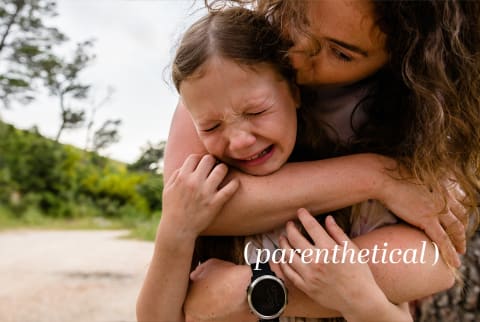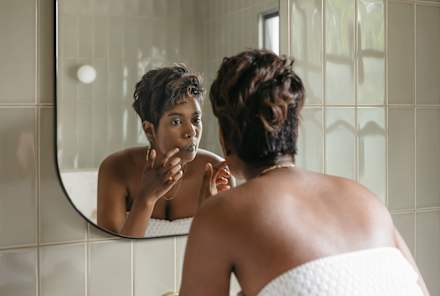Advertisement
How To Cope When Your Kid Is Acting Out — A Psychotherapist Weighs In


"Is this (tantrum, meltdown, mean statement) about me or developmentally appropriate behavior?" is a question that comes up a lot for parents in therapy and support circles.
I can relate: When my toddler isn't sleeping well, I wonder if it's because she is not getting enough time with me during the day. When my infant cries when I leave the room, I wonder if this is normal separation anxiety or if I am behaving in a way that's making her anxious.
If you grew up with caregivers who weren't transparent about their feelings or didn't help you learn about yours, it may make it difficult for you to understand big emotions or negative behaviors that your children exhibit.
How can you tell the difference between normal developmental expressions versus those that may indicate there's a problem that needs to be addressed? Engage in this six-step process to find out:
Learn about child development
Certain developmental stages are meant to include risk taking and challenging boundaries.
We learn about the limits of our world by rubbing up against them. Toddlers and adolescents, for example, tend to be difficult life phases for parents to navigate. Both developmental stages include exhibiting challenges with listening/taking directions, wild/rowdy behavior, expressing big emotions, and talking back. But rest assured: These are all normal responses to developmental leaps–growing up is hard and long work.
The prefrontal cortex, the part of our brains that is in charge of decision-making, doesn't fully develop until the age of 25. Your child is not trying to sabotage you; they are just still learning how to regulate their thoughts, feelings, and behaviors. This does not mean that these behaviors don't warrant your attention, but it's to remind you that they are normal.
However, what tends to happen for many parents is we take these behaviors personally. If your toddler won't put on her coat despite being asked 10 times or if your teen says he hates you, it's easy to feel like you want to teach a lesson or rectify a problem. Difficult behavior is often trying to send us a message, but it's not necessarily indicative of a problem.
Regardless of whether your child is expressing a need or just going through a difficult life moment, it's our job to listen and pay close attention to what that message they are trying to communicate is.
Take care of yourself before intervening with your child
In these tough moments, often referred to as survival moments, it's normal for you to feel self-doubt or dysregulation. It is important that you take care of yourself before giving in to the temptation to rectify the situation with your child. As humans, we co-regulate. This means, the nervous system of the parent either provides regulation or dysregulation for the child. For example, if you are energetically wound up, very agitated, or forceful, this will likely add to the problem, not solve it.
Building your own window of tolerance—or your capacity to be with difficult emotions and ground yourself throughout—is essential to developing a connected relationship with your child.
What does this look like in reality? Create a nourishment menu of people to connect to and strategies to employ that support you in feeling seen, soothed, grounded, and secure.
Examples include:
- Playing soothing music
- Texting a friend to let her know how hard parenting feels
- Squeezing a stress ball
- Allowing someone else to look after the child while you take a walk outside
- Moving your body in any way that brings you joy
- Having a warm cup of herbal tea
- Whatever feels right to you! You know your body and mind better than anyone else
How can you practice these strategies in moments of peace, to ensure you can then draw on them in moments of turmoil?
Connect with your child, before you redirect them
When we see our children going through difficult experiences—whether it's a 30-minute tantrum or your teen not wanting to open up to you—it can be hard not to ask, what's wrong with them? or "What is the problem I need to fix?" This is our survival brain doing its job—we've evolved to worry so that we can predict threats before they harm us.
Instead of asking "What is wrong?" what would it be like to ask, "What is happening here, for me and for my kid?"
Even if your child is exhibiting some sign that they need extra support or something is not right in your relationship with them, the emotion they are expressing is never the problem. Rather, I invite you to look at it this way: It's how we respond to it that presents opportunities for connection or disconnection in our relationship.
For example, if your toddler hits his sibling and you yell at him, he will likely not open up about what he's feeling that is leading him to hit. However, if you remove him from the triggering situation letting him know that behavior isn't OK, and then connect with him to support him in regulating (aggression often comes from dysregulation and overwhelm), there's a higher likelihood that the behavior will both stop and be addressed in a relationally affirming way.
According to psychiatrist Dan Siegel, Ph.D., connecting with our children before we redirect or reprimand them not only dampens the reactivity in the moment but also helps build their brain and our relationship with them.
Go toward the difficult emotion; don't come up against it
By approaching ourselves and our children with curiosity rather than judgment, we open up more possibilities for healing and connection. I often remind myself that the bigger a defensive behavior (or the more off-putting it is), the bigger the wound or tender spot it is covering up.
When we feel our buttons are being pushed, it's usually that this little person is trying to send us a message; we just need to figure out what that is. The more at odds we are with the emotion or position of our children, the more they feel they need to defend it, thus furthering the distance between us.
To connect with them requires validating their emotions and experiences (whether or not you agree with them), listening to their side of the story (the more you care about this, the less they will care about holding on to it), and sharing back what you hear (paraphrasing, so they know you get it).
Redirect in a new direction
Consider one lesson you want to teach and the tone you want to teach it in. As adults, we often speak too much. My motto with my children is: Say less, better.
So instead of going on and on about how unacceptable the behavior is and asking questions about why they did something they know they shouldn't do, I state a boundary "You cannot hit your sister," a brief explanation of why "this is not how we act in our family," and teach empathy: "Can you imagine if your sister hit you? How do you think you would feel?"
Humans authentically change behavior not because we are told to but because we are invested in the relationship that the behavior threatens to harm.
To change sustainably, we must care about how the other person experiences us. Feeling understood, appreciated, and seen tells our children that we want a relationship with them, not that we want to be their boss.
Lean into collaboration
It can be easy to believe that you have to figure out how to address behavioral challenges alone. Especially for older kids, don't be afraid to ask them about their behavior and to brainstorm solutions to family challenges with you.
Read your child's behavior for clues, but remember that you don't have to interpret the observations alone. Questions like "Why are you mad; am I contributing to it?" or "What can I do to make you safer in this moment?" takes the guesswork out and gives them space to take ownership of their behavior. It also builds intrinsic motivation. Rather than doing things out of a sense of duty, they can get in touch with their own reasons for showing up respectfully.
The takeaway
Every dynamic is co-created. Examining behaviors within the context of relationships allows us to get curious about their experience without abandoning our own. Giving yourself and your child the gift of inquiry, rather than judgment, creates a safe space for getting to know each other more deeply and fosters genuine connection.











